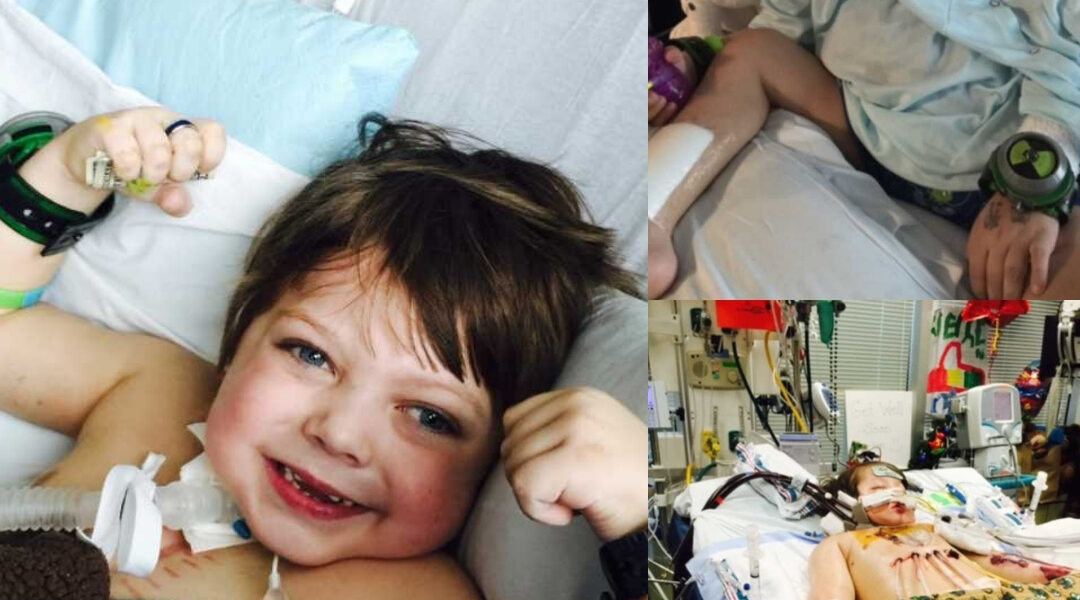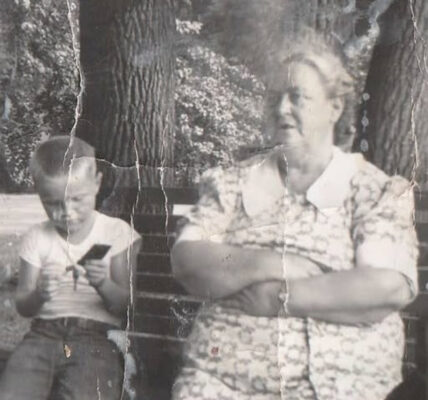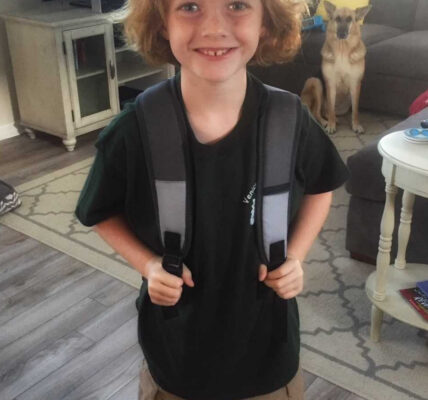When four-year-old Kierken woke up one Thursday morning in March 2015 with a cough and sore throat, his parents, Amanda and Kevin, weren’t overly worried. It sounded like croup, something he’d had before. They made a quick appointment with their local doctor, who examined him, gave him a steroid, and sent them home with reassurance that he would be fine in a few days.
But by that afternoon, Amanda noticed something wasn’t right.
“He was still coughing really badly,” she recalled. “He kept holding his head, crying that it hurt.”
They were preparing to take him back to the doctor when Kierken suddenly fell asleep on the couch. Amanda decided to take a quick shower before they left. That decision — one that took less than ten minutes — would mark the last ordinary moment before her family’s life changed forever.

The Collapse
Amanda had barely stepped into the shower when she heard her husband screaming.
“He’s not breathing right!” Kevin shouted.
Amanda rushed out, wrapped in a towel, to find her little boy gasping, his chest barely moving. In seconds, panic took over. They called 911 as Amanda held her son’s hand, whispering prayers through tears.
Paramedics arrived fast and rushed Kierken to the nearest hospital. His lungs had collapsed. The local team stabilized him just long enough for the Arkansas Children’s Hospital (ACH) transport team to arrive. Within hours, Amanda and Kevin were sitting in the Pediatric Intensive Care Unit, staring through glass at their son — now intubated, hooked up to machines, motionless, his tiny chest rising and falling with the help of a ventilator.
They had no idea they were about to begin the hardest journey of their lives.

A Mystery Infection
At first, doctors thought Kierken had a severe case of croup or pneumonia. But as the hours passed, things grew worse.
By Friday evening, his white blood cell count plummeted, a sign that his body wasn’t fighting infection — it was being overtaken by it. Amanda remembers sitting beside her son’s bed as the monitors began to blare.
“His blood pressure dropped,” she said softly. “They tried everything — fluids, medications — and then… he coded.”
The team started CPR. For endless minutes, Amanda and Kevin watched helplessly as doctors worked to bring him back. When his heart stopped again, they thought they had lost him for good.
“They were giving him epinephrine every two minutes,” Amanda said. “I don’t know how long it went on. It felt like forever.”
Finally, one of the doctors made a last, desperate call: to place him on ECMO — a machine that acts as a heart-and-lung bypass, taking over the job of keeping blood and oxygen moving through the body.
When the surgeons finished, Kierken’s body was swollen and bruised, but alive.
For the next four days, his heart did not beat on its own.

The Diagnosis No Parent Expects
The next morning brought the news that would explain everything: Group A Strep.
A bacteria most parents associate with mild sore throats had invaded Kierken’s bloodstream, turning into a condition known as streptococcal sepsis — a rapidly spreading infection that can cause organ failure and death within hours.
“He was fighting for his life,” Amanda said. “They told us his chances were low, but we refused to give up.”
By Saturday evening, doctors delivered another blow. The ECMO machine wasn’t providing enough support. They needed to open Kierken’s chest and connect the ECMO directly to his heart, a surgery that carried only a 5% chance of survival.
Without it, he wouldn’t live through the night.
Amanda remembers gripping Kevin’s hand so tightly it hurt. “We had no choice but to say yes,” she said. “We told God to take control.”
Against all odds, the surgery succeeded.
“He made it,” the doctor told them afterward, tears in his eyes. “He’s the first child we’ve ever tried this on.”

74 Days on ECMO
The days that followed were a blur of exhaustion, fear, and fragile hope. Kierken remained on ECMO for 74 days, his chest left open for most of that time. Each morning, Amanda woke to a new list of complications — blood clots, infections, bleeding.
“He got two more infections while he was there,” Amanda said. “Every time we thought we were turning a corner, something else happened.”
When doctors tried to take him off the machine, his body couldn’t regulate carbon dioxide. They tried again and again, each time praying it would work. It didn’t.
Then his arteries began to weaken. His chest filled with blood, requiring emergency surgeries to clear it. The medical team knew he couldn’t stay on ECMO much longer. His small body simply couldn’t take it.
That’s when the team came up with something that had never been done before.

The Miracle Procedure
After extensive research, the surgeons proposed a new approach: instead of using ECMO to pump blood, they would remove the pump and connect only the membrane — the part that filtered carbon dioxide — to the artery and vein in Kierken’s thigh. His heart would become the pump.
It was a bold, experimental plan — essentially turning Kierken’s body into its own life-support system.
And it worked.
“After two weeks, his CO₂ levels stabilized,” Amanda said. “They were finally able to close his chest.”
She cried when she saw him without the tubes, the first time his face looked like her little boy again.
The Long Road Back

After more than two months on life support, Kierken’s body was frail and unresponsive. He had been heavily sedated for so long that no one knew how much function he would regain.
Doctors warned the family that he might need a tracheostomy (a breathing tube through his neck) because of the damage to his lungs.
Then, on Easter Sunday — April 5, 2015 — they tried to remove the ventilator. For a brief, beautiful moment, he breathed on his own. Amanda and Kevin held each other, crying tears of joy.
But soon, his little body grew tired. His lungs were too weak.
“He was trying so hard,” Amanda said. “But we could see he was wearing himself out.”
They made the decision to proceed with a trach and a Mickey button feeding tube.
It was the right choice. Within a week, Kierken had more energy. His color improved. Slowly, his eyes opened wider. For the first time in months, he smiled.
“I’ll never forget that smile,” Amanda said. “It was like the sun came back.”
Seven and a Half Months Later

Kierken spent another month in the PICU before being moved to rehab. There, he began the slow process of relearning everything — how to sit up, how to walk, how to eat and drink.
He had to wean off all his medications, his muscles trembling under the strain. Yet every small milestone felt like a miracle.
“Watching him stand again — even for a few seconds — was like watching him take his first steps all over again,” Amanda said.
After seven and a half months in the hospital, on July 28, 2015, the family finally went home.
A Voice Waiting to Return
Today, Kierken is thriving. His trach was removed, his feeding tube gone. The only reminder of that terrifying chapter is his soft whisper — a result of his vocal cords fusing together while on the ventilator.
In December, doctors scheduled a surgery to separate them, a procedure that would allow him to speak clearly again.
“He’s so excited,” Amanda said with a laugh. “He’s already planning what the first thing he’s going to say will be.”
She smiles when she looks at him now — strong, smiling, full of life.
“He’s a living, breathing miracle,” she said. “The things those doctors did for the first time — they’ll save other children because of him. His story gives hope.”
The Lessons Left Behind
Amanda says the experience changed her forever.
“It saved me,” she said. “It made me love life differently. I learned to be thankful for everything — even the hard days. Every breath, every sunrise, every giggle from my son feels like a gift.”
But she also carries a warning for other parents: sepsis can come from something as common as strep throat.
“Never assume it’s ‘just a virus,’” she said. “If something feels wrong, push for answers. It could save your child’s life.”
What began as a cough nearly took everything from them. But by grace, skill, and love, they got their miracle.
And every time Kierken laughs — that bright, boundless laugh that fills their home again — Amanda remembers the words she whispered in the hospital months ago:
“Keep fighting, baby. The world still needs your light.”




